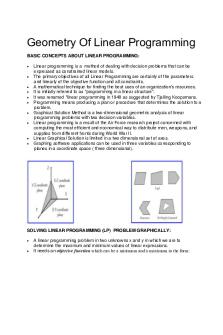Linear Programming: Sensitivity analysis and interpretation of solution PDF

| Title | Linear Programming: Sensitivity analysis and interpretation of solution |
|---|---|
| Course | Introduction to Management Science |
| Institution | Laurentian University |
| Pages | 3 |
| File Size | 77.1 KB |
| File Type | |
| Total Downloads | 91 |
| Total Views | 150 |
Summary
Professor: Shashi Shahi...
Description
Linear Programming: Sensitivity analysis and interpretation of solution -
Sensitivity Analysis - How changes in the coefficients of an optimization model affect the optimal solution - Changes include - Change in a coefficient of the objective function - Change in the right-hand-side value for a constraint - Importance - Real world problems exist in a changing environment - Prices change - Demand changes - New machinery is purchased - Stock prices fluctuate - Employee turnover - Etc
-
Range of optimality - Provides the range of values over which the current solution will remain optimal
-
Sensitivity Analysis: Computer solution - Optimal Objective Value = 7668.00000 -
-
-
Variable
Value
Reduced Cost
S
540.00000
0.00000
D
252.00000
0.00000
Optimal Solution and objective value - Optimal solution: S = 540, D = 252 - Maximum profit = 7668 Reduced Cost - On S and D is 0 - This means that the change in S and D by one unit will not have an effect on the optimal solution
-
-
Slack/surplus Constraint
Slack/Surplus
1
0.00000
2
120.00000
3
0.00000
4
18.00000
Dual value Dual Value 4.37500 0.00000 6.93750 0.00000 -
-
With an additional 1 hour to constraint 1, the optimal value will increase by $4.37 - With an additional 1 hour to constraint 3, the optimal value increases by $6.94 Objective coefficients
-
Variable
Objective Coefficient
Allowable Increase
Allowable Decrease
S
10.00000
3.50000
3.70000
D
9.00000
5.28571
2.33333
Allowable increase or decrease without changing the optimal solution
-
Constraints
-
Constraint
RHS Value
Allowable Increase
Allowable Decrease
1
630.00000
52.36364
134.40000
2
600.00000
Infinite
120.00000
3
708.00000
192.00000
128.00000
4
135.00000
Infinite
18.00000
Allowable increase or decrease without changing the optimal solution
Limitations of classical sensitivity analysis - Simultaneous changes in input data - Sensitivity analysis is based on the assumption that only one coefficient and everything else remains the same - In the real world, 2 or more coefficients can change simultaneously - Re-run the model with changed coefficients - Changes in constraint coefficients - Sensitivity analysis provides no information about changes resulting from a change in the coefficient of a variable in a constraint - Non-intuitive dual values - Constraints with variables on both left and right sides often lead to dual values that have a no-intuitive explanation...
Similar Free PDFs

Geometry Of Linear Programming
- 6 Pages

Linear Programming
- 40 Pages

Sensitivity analysis 1
- 2 Pages

Sensitivity Analysis 2
- 2 Pages

Linear Programming Part 3
- 6 Pages

Linear Programming Special Cases
- 8 Pages

A6.Linear Programming
- 3 Pages
Popular Institutions
- Tinajero National High School - Annex
- Politeknik Caltex Riau
- Yokohama City University
- SGT University
- University of Al-Qadisiyah
- Divine Word College of Vigan
- Techniek College Rotterdam
- Universidade de Santiago
- Universiti Teknologi MARA Cawangan Johor Kampus Pasir Gudang
- Poltekkes Kemenkes Yogyakarta
- Baguio City National High School
- Colegio san marcos
- preparatoria uno
- Centro de Bachillerato Tecnológico Industrial y de Servicios No. 107
- Dalian Maritime University
- Quang Trung Secondary School
- Colegio Tecnológico en Informática
- Corporación Regional de Educación Superior
- Grupo CEDVA
- Dar Al Uloom University
- Centro de Estudios Preuniversitarios de la Universidad Nacional de Ingeniería
- 上智大学
- Aakash International School, Nuna Majara
- San Felipe Neri Catholic School
- Kang Chiao International School - New Taipei City
- Misamis Occidental National High School
- Institución Educativa Escuela Normal Juan Ladrilleros
- Kolehiyo ng Pantukan
- Batanes State College
- Instituto Continental
- Sekolah Menengah Kejuruan Kesehatan Kaltara (Tarakan)
- Colegio de La Inmaculada Concepcion - Cebu








